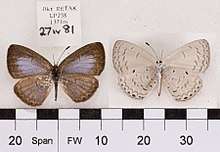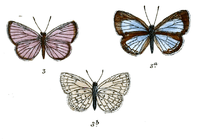Monodontides musina
Monodontides musina, the Swinhoe's hedge blue,[2] is a butterfly of the family Lycaenidae. It is found in South-East Asia, including India.[3]
| Monodontides musina | |
|---|---|
 | |
| Scientific classification | |
| Kingdom: | |
| Phylum: | |
| Class: | |
| Order: | |
| Family: | |
| Genus: | |
| Species: | M. musina |
| Binomial name | |
| Monodontides musina | |
| Synonyms | |
| |
Description
Male underside: pale lilacine grey. Forewing: costa bordered by a slender line, termen by a comparatively broad and even band of dusky black, the latter diffuse along its inner margin. Hindwing: costal margin diffusely dusky black, termen with a slender black anteciliary line; dorsal margin narrowly pale. Underside: white with a slight tinge of blue. Forewing: a short line on the discocellulars, a postdiscal transverse series of six abbreviated lines pointing obliquely outwards and en echelon one with the other, the uppermost shifted well inwards, followed by a subterminal series of transverse spots enclosed between an inner subterminal, lunular, transverse line and an outer anteciliary slender line, pale brown. Hindwing: a transverse subbasal series of three, sometimes four, minute spots and a spot beyond on the dorsum, with a larger subcostal spot near the apex of the wing, black; a short slender line on the discocellulars and some irregular dots on the disc pale brown; terminal markings as on the forewing. Cilia of both forewings and hindwings whitish. Antenna, head, thorax and abdomen dark brown, the antennae ringed with white beneath: the palpi, thorax and abdomen white.
Female upperside, forewing: a broad border to the costal and terminal margins dusky black, the rest of the wing iridescent light blue; on the costa the lower edge of the black traverses the middle of the cell, on the apex and termen it occupies the outer fourth of the wing. Hindwing: anterior third dusky black, the rest of the wing pale lilacine glossed with iridescent blue in certain lights; a subterminal series of dusky black spots that more or less coalesces with an anteciliary dusky black hue and is enclosed on the inner side by a slender similarly-coloured lunular line. The underside, antennae, head, thorax and abdomen as in the male.[4]
Taxonomy
The butterfly was earlier known as Lycaenopsis musina Swinhoe.[3]
Subspecies

- Monodontides musina musina (Java, Malaysia)
- Monodontides musina musinoides (Swinhoe, 1910) (north-eastern India, Burma, northern Thailand, Yunnan)
- Monodontides musina pelides (Fruhstorfer, 1910) (southern Laos, southern Vietnam)
References
| Wikimedia Commons has media related to Monodontides musina. |
| Wikispecies has information related to Monodontides musina |
- "Monodontides Toxopeus, 1927" at Markku Savela's Lepidoptera and Some Other Life Forms
- Beccaloni, G.; Scoble, M.; Kitching, I.; Simonsen, T.; Robinson, G.; Pitkin, B.; Hine, A.; Lyal, C., eds. (2003). "Celastrina musina". The Global Lepidoptera Names Index. Natural History Museum. Retrieved April 21, 2018.
- Evans, W.H. (1932). The Identification of Indian Butterflies (2nd ed.). Mumbai, India: Bombay Natural History Society. pp. 221–226, ser no H21.18.
- Bingham, C.T. (1907). The Fauna of British India, Including Ceylon and Burma. II (1st ed.). London: Taylor and Francis, Ltd.
- Beccaloni, George; Scoble, Malcolm; Kitching, Ian; Simonsen, Thomas; Robinson, Gaden; Pitkin, Brian; Hine, Adrian; Lyal, Chris. "The Global Lepidoptera Names Index (LepIndex)". Natural History Museum, London. Retrieved 2016-10-15.
- Evans, W.H. (1932). The Identification of Indian Butterflies (2nd ed.). Mumbai, India: Bombay Natural History Society.